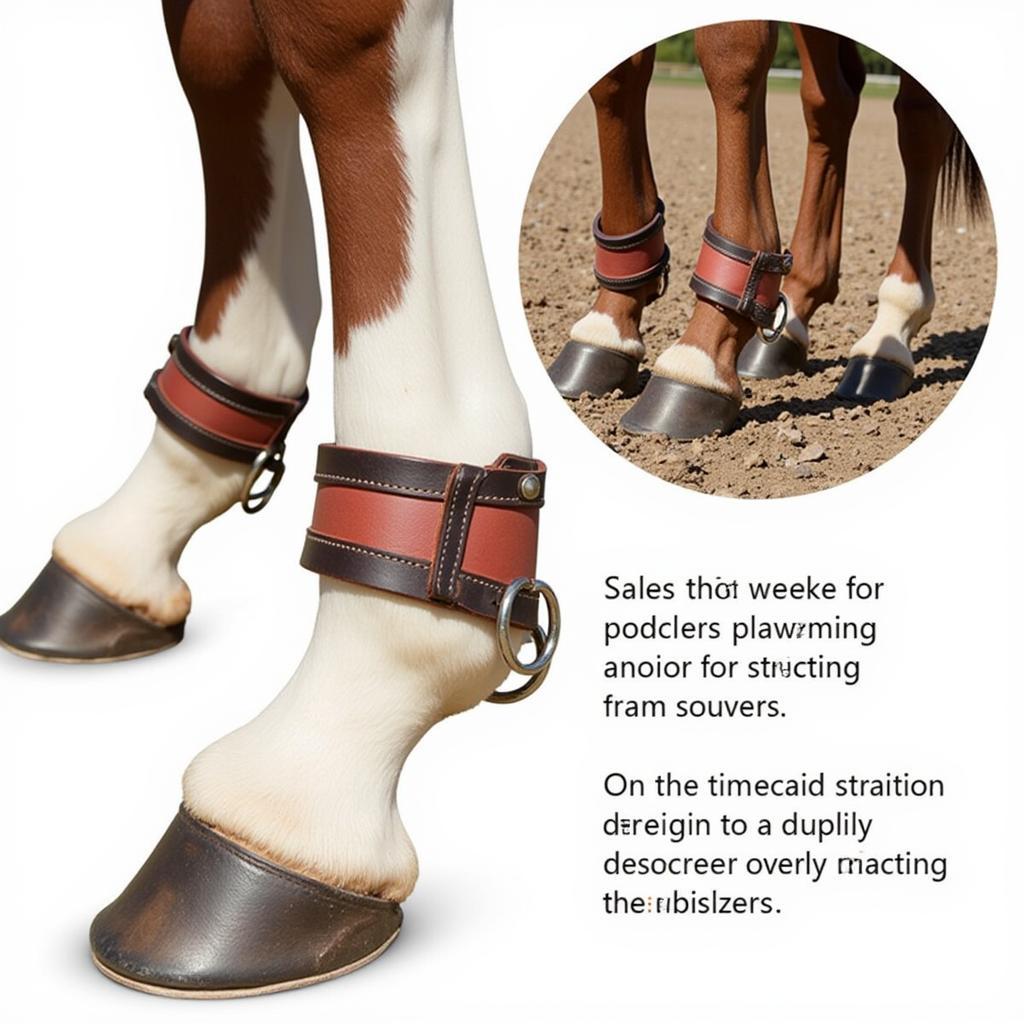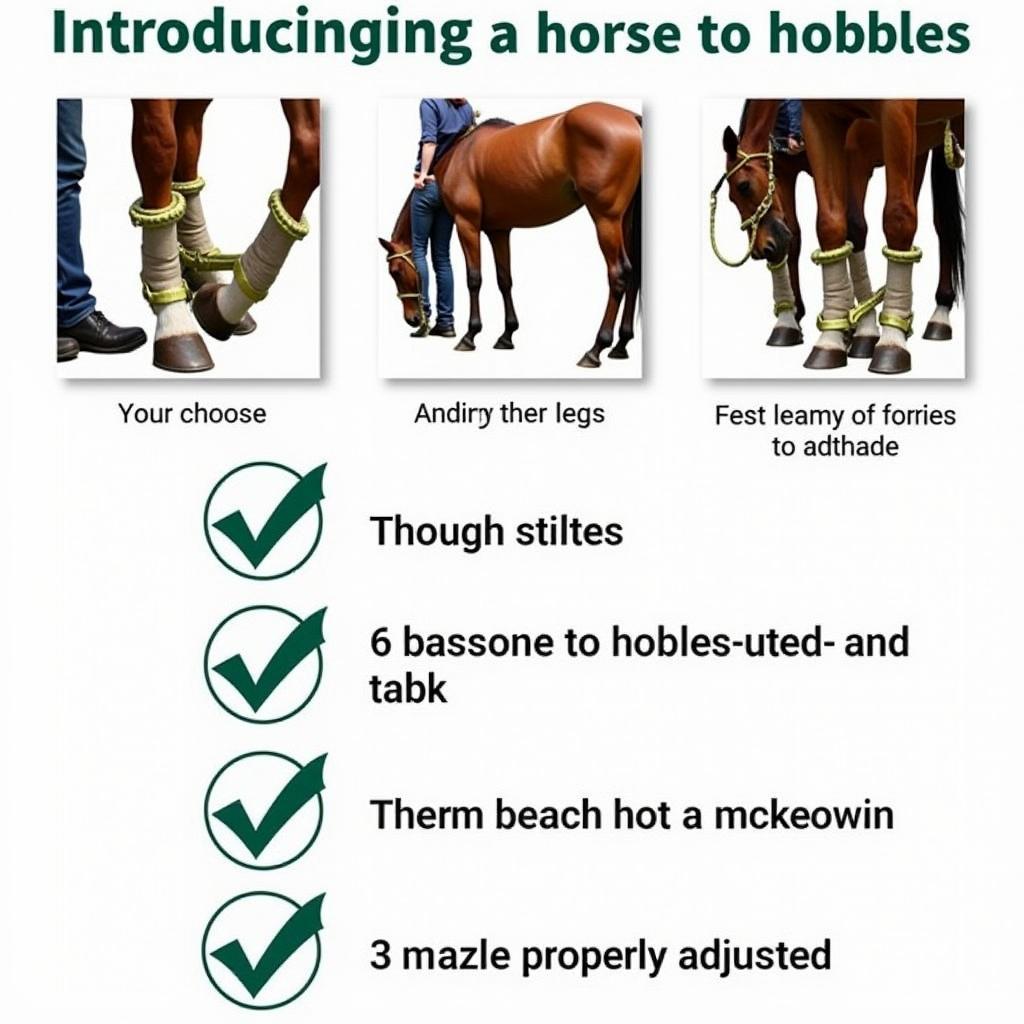Leather Horse Hobbles are a common piece of equipment used to restrict a horse’s movement. Understanding their proper use, different types, and potential risks is crucial for any horse owner. This guide will delve into the world of leather horse hobbles, offering valuable insights and practical advice for their safe and effective application.
Choosing the Right Leather Horse Hobbles
Selecting the correct leather horse hobbles is essential for your horse’s well-being and safety. Consider the following factors when making your purchase: the type of leather, the length and adjustment options, and the overall construction. High-quality leather, durable stitching, and proper fit are key to preventing injuries and ensuring long-lasting use. You should also consider the specific needs of your horse and the activities for which you intend to use the hobbles.
Different types of leather horse hobbles cater to various needs. For instance, some hobbles have a chain connecting the two leg straps, offering a bit more movement, while others have a solid leather connector for greater restriction. Some have a swivel to avoid the horse getting tangled. Understanding the nuances of each type will help you make an informed decision. Ask yourself, what level of restriction is necessary for my horse? What type of terrain will my horse be on while hobbled?
After a paragraph on choosing hobbles for mountain pack horse, we’ll discuss the proper fitting.
Mountain pack horses often wear hobbles in the backcountry. Choosing the correct type and fit of hobbles is especially important with mountain pack horses, to prevent accidents and injuries during their journeys.
Fitting Leather Horse Hobbles Correctly
Proper fitting is crucial to prevent injuries and discomfort. Hobbles should be adjusted so they allow for some movement but prevent the horse from taking large strides. Too loose, and they become ineffective; too tight, and they can cause chafing or restrict circulation. Always ensure the hobbles are placed correctly on the horse’s pasterns and secured snugly but not excessively tight.
When fitting leather horse hobbles, always double-check your work. Run your fingers around the straps to make sure there are no twists or pressure points. Observe your horse’s reaction to the hobbles. A relaxed demeanor suggests a comfortable fit, while signs of distress, such as pawing or pulling back, indicate potential problems.
 Leather Horse Hobbles Proper Fit
Leather Horse Hobbles Proper Fit
Safely Introducing Your Horse to Hobbles
Introducing hobbles to a horse requires patience and a calm approach. Start by allowing your horse to become accustomed to the feel of the hobbles by simply handling them around its legs. Gradually introduce the hobbles for short periods, gradually increasing the duration as the horse becomes more comfortable. Always supervise your horse while it is hobbled, especially during the initial stages of introduction.
Never leave a hobbled horse unattended. Even a seasoned hobbled horse can encounter unexpected situations that could lead to injury. Ensure the area where the horse is hobbled is free of hazards such as fences, trees, or uneven terrain. Regularly check the hobbles for signs of wear and tear, and replace them as needed.
Key Considerations for Hobbling
- Terrain: Choose a flat, even surface, especially when introducing hobbles.
- Supervision: Never leave a hobbled horse unattended.
- Duration: Start with short periods and gradually increase the time.
- Safety Check: Regularly inspect the hobbles and the surrounding area.
 Introducing a Horse to Hobbles Safely
Introducing a Horse to Hobbles Safely
Maintaining Leather Horse Hobbles
Proper maintenance will extend the lifespan of your leather horse hobbles. Regularly cleaning and conditioning the leather will keep it supple and prevent cracking. Store your hobbles in a cool, dry place away from direct sunlight and moisture. Inspect the hardware for any signs of damage and replace it as needed.
Cleaning Your Leather Horse Hobbles
Leather horse hobbles can be cleaned by using leather cleaner. Follow the manufacturer’s instructions for use.
Conditioning the Leather
Conditioning the leather will help to keep it supple and prevent drying and cracking. This simple step will significantly prolong the life of your hobbles.
What are the benefits of using leather horse hobbles?
Leather horse hobbles can be a valuable tool for managing horses, providing benefits in various situations, including:
- Controlled Grazing: Hobbles limit a horse’s grazing range, preventing overgrazing in specific areas or allowing for targeted grazing management.
- Training: Hobbles can be used in certain training methods to help a horse learn to stand still or to restrict movement during ground work.
- Veterinary Care: Hobbles can assist in restraining a horse for veterinary procedures, such as vaccinations or wound care.
- Farrier Work: Hobbles can help to keep a horse calm and steady while the farrier is working, making the process safer for both the horse and the farrier.
Conclusion
Leather horse hobbles are valuable tools when used correctly. Understanding the different types, proper fitting, and safe introduction techniques are crucial for responsible horse ownership. By following the guidelines in this comprehensive guide, you can effectively utilize leather horse hobbles while prioritizing your horse’s well-being. Remember to always prioritize safety and consult with an experienced horse professional if you have any questions or concerns.
FAQ
- What type of leather is best for horse hobbles?
High-quality, durable leather is essential for horse hobbles. Look for full-grain or latigo leather. - How long should I leave hobbles on my horse?
Start with short periods, gradually increasing the duration as your horse becomes accustomed to them. Never leave a hobbled horse unattended. - Can hobbles be used on all horses?
While hobbles can be used on most horses, they are not suitable for all. Consult with a veterinarian or experienced horse professional to determine if hobbles are appropriate for your horse. - What should I do if my horse gets tangled in its hobbles?
Remain calm and approach the horse slowly. Carefully untangle the hobbles, ensuring not to frighten or injure the horse. - Where can I buy leather horse hobbles?
Leather horse hobbles can be purchased at most tack stores or online retailers. - How tight should horse hobbles be?
Hobbles should be snug but not so tight that they restrict circulation or cause chafing. They should allow for some movement. - Are there different types of horse hobbles?
Yes, there are various types of hobbles, including leather, rope, and nylon, each with its own advantages and disadvantages.
For further assistance, please contact us: Phone: 0772127271, Email: [email protected] Or visit us at: QGM2+WX2, Vị Trung, Vị Thuỷ, Hậu Giang, Việt Nam. We have a 24/7 customer service team.